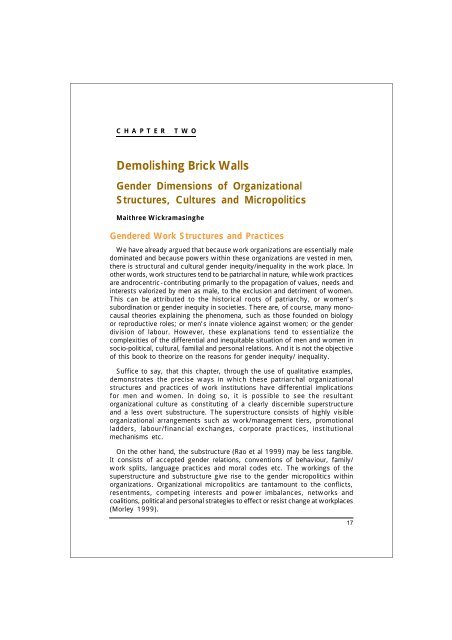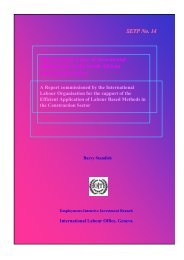Beyond Glass Ceilings and Brick Walls - International Labour ...
Beyond Glass Ceilings and Brick Walls - International Labour ...
Beyond Glass Ceilings and Brick Walls - International Labour ...
You also want an ePaper? Increase the reach of your titles
YUMPU automatically turns print PDFs into web optimized ePapers that Google loves.
CHAPTER TWO<br />
Demolishing <strong>Brick</strong> <strong>Walls</strong><br />
Gender Dimensions of Organizational<br />
Structures, Cultures <strong>and</strong> Micropolitics<br />
Maithree Wickramasinghe<br />
Gendered Work Structures <strong>and</strong> Practices<br />
We have already argued that because work organizations are essentially male<br />
dominated <strong>and</strong> because powers within these organizations are vested in men,<br />
there is structural <strong>and</strong> cultural gender inequity/inequality in the work place. In<br />
other words, work structures tend to be patriarchal in nature, while work practices<br />
are <strong>and</strong>rocentric-contributing primarily to the propagation of values, needs <strong>and</strong><br />
interests valorized by men as male, to the exclusion <strong>and</strong> detriment of women.<br />
This can be attributed to the historical roots of patriarchy, or women’s<br />
subordination or gender inequity in societies. There are, of course, many monocausal<br />
theories explaining the phenomena, such as those founded on biology<br />
or reproductive roles; or men’s innate violence against women; or the gender<br />
division of labour. However, these explanations tend to essentialize the<br />
complexities of the differential <strong>and</strong> inequitable situation of men <strong>and</strong> women in<br />
socio-political, cultural, familial <strong>and</strong> personal relations. And it is not the objective<br />
of this book to theorize on the reasons for gender inequity/ inequality.<br />
Suffice to say, that this chapter, through the use of qualitative examples,<br />
demonstrates the precise ways in which these patriarchal organizational<br />
structures <strong>and</strong> practices of work institutions have differential implications<br />
for men <strong>and</strong> women. In doing so, it is possible to see the resultant<br />
organizational culture as constituting of a clearly discernible superstructure<br />
<strong>and</strong> a less overt substructure. The superstructure consists of highly visible<br />
organizational arrangements such as work/management tiers, promotional<br />
ladders, labour/financial exchanges, corporate practices, institutional<br />
mechanisms etc.<br />
On the other h<strong>and</strong>, the substructure (Rao et al 1999) may be less tangible.<br />
It consists of accepted gender relations, conventions of behaviour, family/<br />
work splits, language practices <strong>and</strong> moral codes etc. The workings of the<br />
superstructure <strong>and</strong> substructure give rise to the gender micropolitics within<br />
organizations. Organizational micropolitics are tantamount to the conflicts,<br />
resentments, competing interests <strong>and</strong> power imbalances, networks <strong>and</strong><br />
coalitions, political <strong>and</strong> personal strategies to effect or resist change at workplaces<br />
(Morley 1999).<br />
17
















